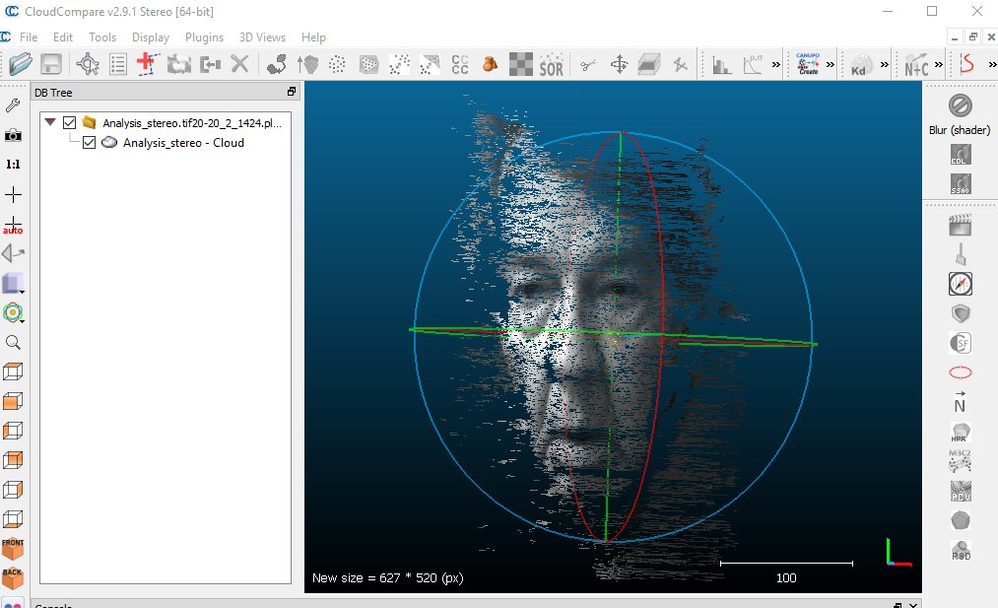- Mark as New
- Bookmark
- Subscribe
- Mute
- Subscribe to RSS Feed
- Permalink
- Report Inappropriate Content
I am using the SR300 camera, I plan the first step of 3D geometry reconstruction, then texture mapping. Is there a code sample for python?
- Mark as New
- Bookmark
- Subscribe
- Mute
- Subscribe to RSS Feed
- Permalink
- Report Inappropriate Content
For the SR300, the best option I can think of is software called CloudCompare, which has been demonstrated to be usable with RealSense for capturing a face as a point cloud.
The images above were captured with a D415 model, though I don't believe that CloudCompare is tied to a specific camera model, and there was a case where an SR300 was successfully used with CloudCompare
https://www.reddit.com/r/computervision/comments/7ifc71/3d_point_cloud_labelling_tool/
Link Copied
- Mark as New
- Bookmark
- Subscribe
- Mute
- Subscribe to RSS Feed
- Permalink
- Report Inappropriate Content
Pyntcloud would likely fit your needs. It allows you to create models using a type of depth scan called a point cloud, and then apply further processing such as conversion to a solid mesh-based model. It has been recommended in the past by Dorodnic the RealSense SDK Manager as a point cloud solution for Python.
Pyntcloud
https://github.com/daavoo/pyntcloud
Documentation
https://pyntcloud.readthedocs.io/en/latest/
Example tutorials
https://github.com/daavoo/pyntcloud/tree/master/examples
Converting a point cloud to a mesh with Pyntcloud (advice by Pyntcloud's creator)
https://stackoverflow.com/questions/44997054/point-cloud-to-volume
- Mark as New
- Bookmark
- Subscribe
- Mute
- Subscribe to RSS Feed
- Permalink
- Report Inappropriate Content
I used pyntcloud before, but I can only run it on a web page. So I tried to use py-pcl to splicing the face cloud. Do you have a good plan or idea to let me learn from it?
- Mark as New
- Bookmark
- Subscribe
- Mute
- Subscribe to RSS Feed
- Permalink
- Report Inappropriate Content
I am not familiar with py-pcl. Another approach you could consider would be a technique called Poisson Surface Reconstruction. Below is an example for Python.
- Mark as New
- Bookmark
- Subscribe
- Mute
- Subscribe to RSS Feed
- Permalink
- Report Inappropriate Content
thank you very much .I learned about pypoisson.It can meet my needs. Now I have a problem with the installation. I am using python3, the installation steps prompted in the webpage I failed to install using pip.
- Mark as New
- Bookmark
- Subscribe
- Mute
- Subscribe to RSS Feed
- Permalink
- Report Inappropriate Content
Have you tried the pip installation instruction below, please? Ignore the clickable link, and copy-and-paste the whole line.
pip install git+https://github.com/mmolero/pypoisson.git
- Mark as New
- Bookmark
- Subscribe
- Mute
- Subscribe to RSS Feed
- Permalink
- Report Inappropriate Content
Yes, I tried it and showed that the wheel installation failed. Is there a way to download the pypoisson wheel file directly?
- Mark as New
- Bookmark
- Subscribe
- Mute
- Subscribe to RSS Feed
- Permalink
- Report Inappropriate Content
I'm not familiar with the concept of Python wheel files (I'm usually a Windows guy). You can research the subject though by googling for 'python wheel installation'. Here's an example:
https://stackoverflow.com/questions/21222114/how-do-i-install-python-libraries-in-wheel-format
There are also alternative installation instructions on the front page of pypoisson:
$ git clone --recursive git://github.com/mmolero/pypoisson.git
$ python setup.py build
$ python setup.py install
- Mark as New
- Bookmark
- Subscribe
- Mute
- Subscribe to RSS Feed
- Permalink
- Report Inappropriate Content
Thank you very much for inspiring me. Now I am considering the use of ICP algorithm to achieve the fusion of face point cloud data. I want to know what methods I can recommend using the SR300 camera. Here I will collect facial point cloud data from several different angles and then perform point cloud registration.Really thank you for your help.
- Mark as New
- Bookmark
- Subscribe
- Mute
- Subscribe to RSS Feed
- Permalink
- Report Inappropriate Content
For the SR300, the best option I can think of is software called CloudCompare, which has been demonstrated to be usable with RealSense for capturing a face as a point cloud.
The images above were captured with a D415 model, though I don't believe that CloudCompare is tied to a specific camera model, and there was a case where an SR300 was successfully used with CloudCompare
https://www.reddit.com/r/computervision/comments/7ifc71/3d_point_cloud_labelling_tool/
- Subscribe to RSS Feed
- Mark Topic as New
- Mark Topic as Read
- Float this Topic for Current User
- Bookmark
- Subscribe
- Printer Friendly Page

